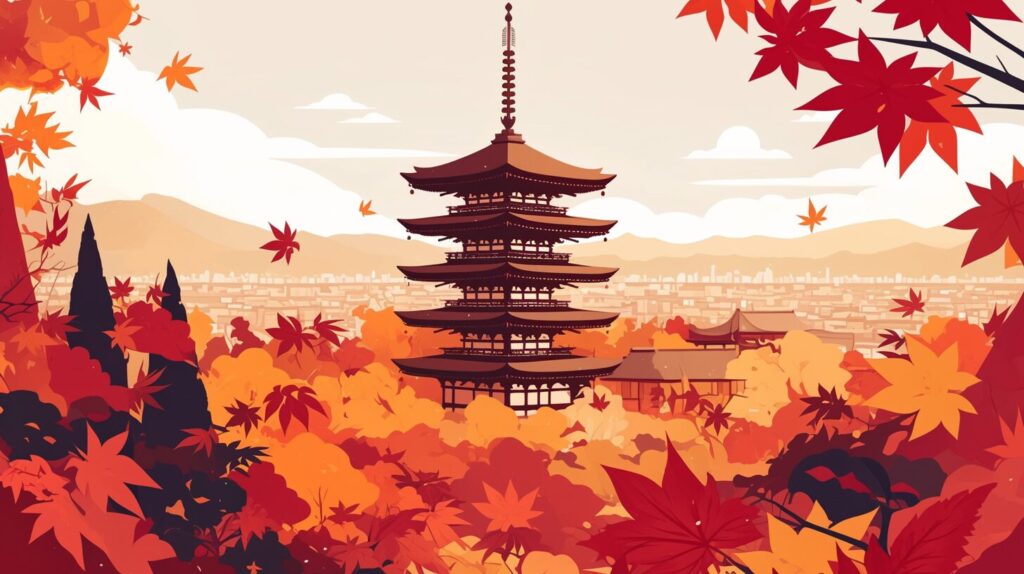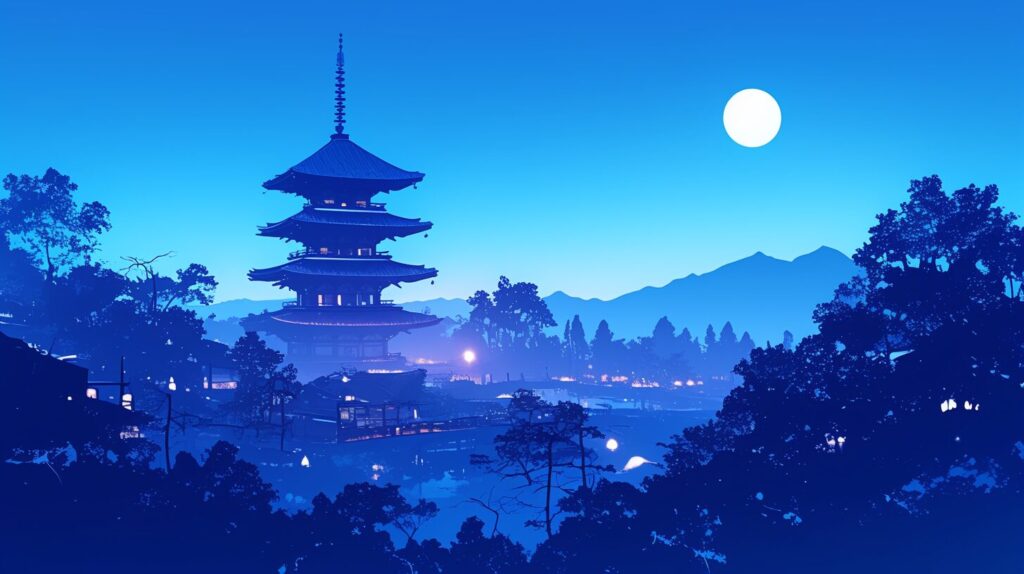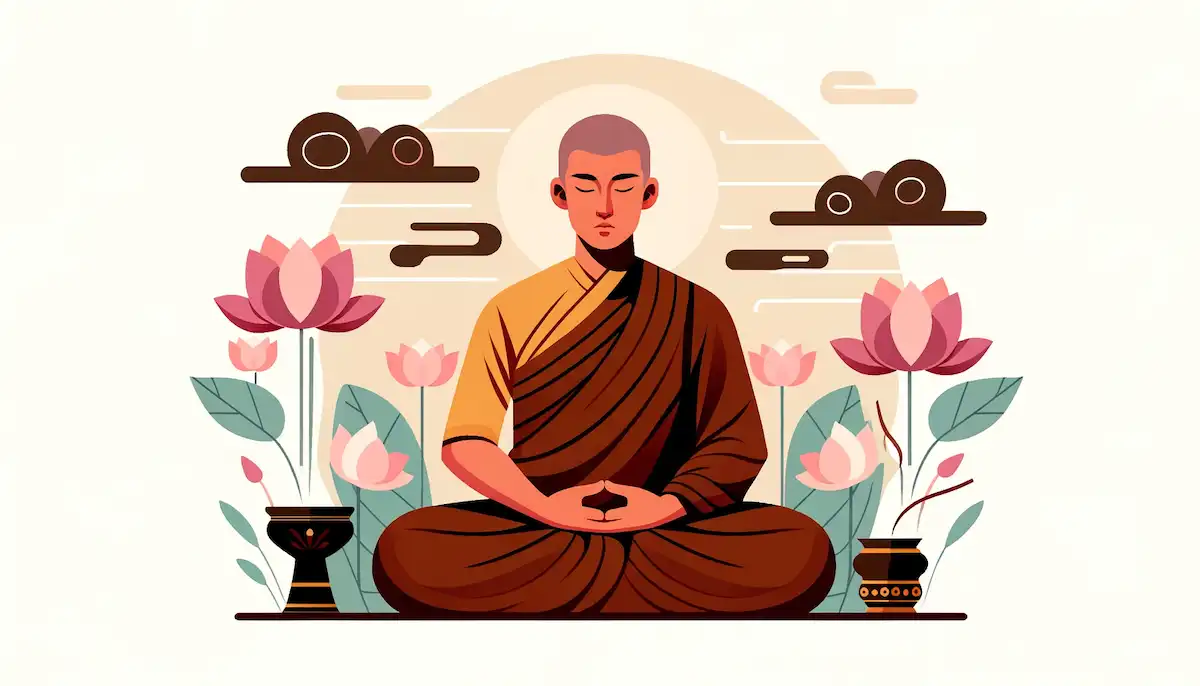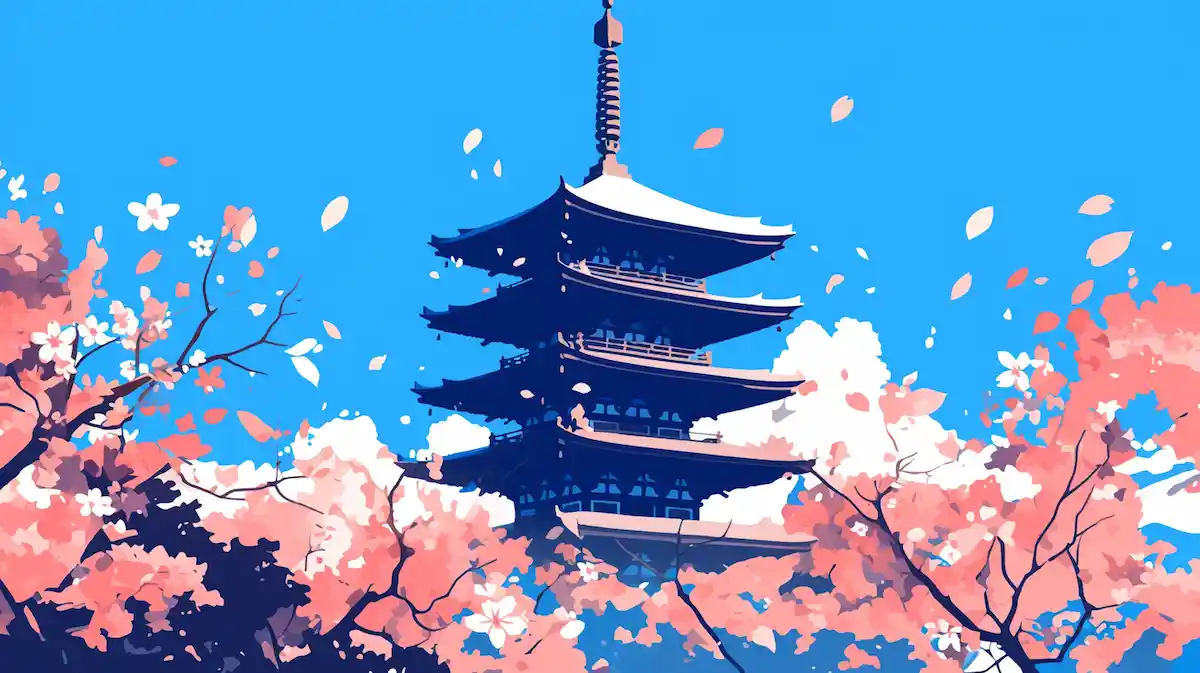東寺(教王護国寺)を英語で説明・紹介するための基本情報と、英会話に役立つ表現をシンプルでわかりやすい英語で紹介します。
英会話ダイアローグ・概要・10の質問を通して、東寺に関する英語表現を学びます。
英語
英会話ダイアローグを読む前に知っておくと良い前提知識と情報です。
- 東寺の基本情報
- 東寺の正式名称は教王護国寺、796年に国家による官寺として建てられた
- 東寺の歴史
- 823年、嵯峨天皇が弘法大師(空海)に東寺を託し、以後、真言密教の中心地として発展
- 1994年に「古都京都の文化財」としてユネスコ世界遺産に登録
- 東寺の主要な特徴と見どころ
- 五重塔: 高さ54.8メートルで、日本一高い木造の塔
- 講堂の立体曼荼羅: 21体の仏像が配置された三次元的な曼荼羅(仏教の世界観を表現するもの)
- 金堂: 東寺の本堂で、薬師如来像を安置
- 御影堂: 弘法大師が住んでいた場所とされ、現在も信仰の中心
- 季節のイベントと楽しみ方
- ライトアップ: 春の桜や秋の紅葉シーズンには、五重塔や庭園がライトアップされ、幻想的な景色が楽しめる
- 弘法市: 毎月21日に開催されるマーケットで、骨董品や手作りの工芸品、食べ物などを楽しめる
2人が東寺(教王護国寺)について話しています。
東寺の歴史、空海との関係、五重塔、講堂の立体曼荼羅、弘法市などを話題にしています。
会話 / dialogue

Hey Key, I’ve been planning a trip to Kyoto and heard about a place called To-ji. Do you know much about it?

Yes, To-ji is one of the most famous temples in Kyoto. It has a history of over 1,200 years. Are you interested in temples?

Kind of. I like places with deep history. What makes To-ji special?

Well, it’s the only state-sponsored temple from the Heian period that still exists. It was built in 796 when Kyoto became the capital, and later, in 823, Emperor Saga entrusted it to Kobo Daishi.

Kobo Daishi? That name sounds familiar. He’s an important figure in Buddhism, right?

Exactly. He’s the founder of Shingon Buddhism. After studying in China, he brought Esoteric Buddhism to Japan. To-ji became the main training center for Shingon Buddhism under his leadership.

That’s fascinating. Does the temple have any unique features?

Definitely. The most iconic is the five-story pagoda. It’s the tallest wooden pagoda in Kyoto and one of the tallest in Japan, standing at 54.8 meters.

That must be impressive. Is it open to visitors?

The inside is only open during special events, but the exterior is beautiful. It’s especially stunning during cherry blossom season in spring or the autumn leaves when they light it up at night.

Sounds like a photographer’s dream. What else is there to see?

The Lecture Hall is another highlight. It has 21 statues arranged in a three-dimensional mandala that represents the Buddhist cosmos.

A three-dimensional mandala? That sounds unique.

It is. There’s also the Main Hall, which houses Yakushi Nyorai, the Medicine Buddha, and the Mieido Hall, where Kobo Daishi once lived.

So it’s not just about history but also about spiritual significance.

Exactly. If you go on the 21st of any month, you can also experience the Kobo Market. It’s a lively event with stalls selling antiques, crafts, and food.

That sounds like so much fun! Is it easy to get there?

Very easy. It’s about a 15-minute walk from Kyoto Station or 10 minutes from Kintetsu To-ji Station.

Perfect. What’s the best time of year to visit?

Spring for the cherry blossoms and autumn for the leaves are the most popular. The light-up events during these seasons are breathtaking.

I’m definitely adding To-ji to my list. Thanks, Key. You’ve really got me excited about this!

You’re welcome, Mack. I think you’ll love it. Let me know how it goes when you visit!
概要 / Overview
「東寺」について、理解を深めるための「英語での概要」です。
東寺(教王護国寺)

Introduction to To-ji Temple
To-ji Temple, officially called Kyo-o Gokoku-ji, is one of the most famous temples in Kyoto, Japan. It was built in 796 during the Heian period when Kyoto became the capital of Japan. To-ji means “East Temple,” as it was part of two temples that protected the eastern and western sides of the city. It is the only state-sponsored temple from that time that still exists today. In 1994, To-ji was registered as a UNESCO World Heritage Site as part of the “Historic Monuments of Ancient Kyoto.”
The Connection with Kobo Daishi
In 823, Emperor Saga entrusted To-ji Temple to Kobo Daishi, also known as Kukai. He was the founder of Shingon Buddhism and played a major role in bringing Esoteric Buddhism to Japan after studying in China. Under Kobo Daishi’s leadership, To-ji became the main training center for Shingon Buddhism. His influence can still be felt at the temple today, making it an important spiritual and cultural site.
Key Features of To-ji Temple
To-ji is known for its stunning architecture and cultural treasures. The five-story pagoda is the most famous structure at the temple. Standing at 54.8 meters, it is the tallest wooden pagoda in Kyoto and one of the tallest in Japan. Another highlight is the Lecture Hall, which features a three-dimensional mandala of 21 statues. These statues represent the Buddhist cosmos and the teachings of Shingon Buddhism. The Main Hall (Kondo) houses a statue of Yakushi Nyorai, the Medicine Buddha. Visitors can also see the Mieido Hall, where Kobo Daishi once lived.
Seasonal Beauty and Events
To-ji Temple is beautiful in every season. In spring, cherry blossoms surround the pagoda, creating a stunning view. In autumn, the colorful leaves make the temple even more attractive. During these seasons, the temple holds light-up events, which allow visitors to enjoy the scenery at night. On the 21st of each month, To-ji hosts the Kobo Market, a lively event where visitors can buy antiques, crafts, and local food.
Conclusion
To-ji Temple is a place of history, culture, and spirituality. It offers something for everyone, whether you are interested in architecture, Buddhist teachings, or beautiful scenery. Located just a 15-minute walk from Kyoto Station, it is easy to visit and a must-see destination in Kyoto.
10の質問 / 10 questions
「東寺」について、理解を深めるための「英語での10の質問」です。
1: What is To-ji Temple?
To-ji Temple, officially called Kyo-o Gokoku-ji, is a Buddhist temple in Kyoto, Japan. It was built in 796 during the Heian period and is known for its history and cultural significance.
2: Why is To-ji Temple important?
To-ji is the only state-sponsored temple from the Heian period that still exists today. It became the main center for Shingon Buddhism under Kobo Daishi’s leadership.
3: Who is Kobo Daishi?
Kobo Daishi, also known as Kukai, was the founder of Shingon Buddhism. He brought Esoteric Buddhism to Japan from China and established To-ji as its main training center.
4: What is the most famous feature of To-ji Temple?
The five-story pagoda is the most famous feature of To-ji. It is 54.8 meters tall, making it the tallest wooden pagoda in Kyoto and one of the tallest in Japan.
5: What can you see in the Lecture Hall?
The Lecture Hall has 21 statues arranged in a three-dimensional mandala. These statues represent the Buddhist cosmos and Shingon Buddhist teachings.
6: What makes To-ji beautiful during spring and autumn?
In spring, cherry blossoms surround the pagoda, and in autumn, colorful leaves create stunning scenery. Both seasons also feature light-up events at night.
7: What is the Kobo Market?
The Kobo Market is held on the 21st of every month at To-ji Temple. It is a lively event with stalls selling antiques, crafts, and food.
8: When was To-ji registered as a UNESCO World Heritage Site?
To-ji Temple was registered as a UNESCO World Heritage Site in 1994 as part of the “Historic Monuments of Ancient Kyoto.”
9: How can visitors get to To-ji Temple?
To-ji Temple is about a 15-minute walk from Kyoto Station or a 10-minute walk from Kintetsu To-ji Station, making it easy to access.
10: What is the best time to visit To-ji Temple?
Spring and autumn are the best times to visit. Cherry blossoms in spring and autumn leaves, along with seasonal light-up events, make these seasons especially beautiful.

和訳付
会話 / dialogue

Hey Key, I’ve been planning a trip to Kyoto and heard about a place called To-ji. Do you know much about it?
やあ、キー。京都旅行を計画しているんだけど、東寺という場所を聞いたんだ。どれくらい知ってる?

Yes, To-ji is one of the most famous temples in Kyoto. It has a history of over 1,200 years. Are you interested in temples?
うん、東寺は京都で最も有名な寺院の一つだよ。1200年以上の歴史があるんだ。お寺に興味あるの?

Kind of. I like places with deep history. What makes To-ji special?
まあね。歴史の深い場所が好きなんだ。東寺の特別なところって何?

Well, it’s the only state-sponsored temple from the Heian period that still exists. It was built in 796 when Kyoto became the capital, and later, in 823, Emperor Saga entrusted it to Kobo Daishi.
平安時代に建てられた官寺の中で、今も残っているのは東寺だけなんだよ。796年に京都が都になったときに建てられて、823年には嵯峨天皇が弘法大師に託したんだ。

Kobo Daishi? That name sounds familiar. He’s an important figure in Buddhism, right?
弘法大師?その名前は聞いたことがあるよ。仏教で重要な人物だよね?

Exactly. He’s the founder of Shingon Buddhism. After studying in China, he brought Esoteric Buddhism to Japan. To-ji became the main training center for Shingon Buddhism under his leadership.
その通り。彼は真言宗の創始者だよ。中国で修行して、日本に密教を伝えたんだ。東寺は彼の指導の下で真言密教の修行道場になったんだ。

That’s fascinating. Does the temple have any unique features?
興味深いな。その寺院には何か独特な特徴があるの?

Definitely. The most iconic is the five-story pagoda. It’s the tallest wooden pagoda in Kyoto and one of the tallest in Japan, standing at 54.8 meters.
もちろん。最も象徴的なのは五重塔だよ。高さ54.8メートルで、京都で一番高い木造の塔だし、日本でも有数の高さを誇るんだ。

That must be impressive. Is it open to visitors?
それはすごいね。訪問者は中に入れるの?

The inside is only open during special events, but the exterior is beautiful. It’s especially stunning during cherry blossom season in spring or the autumn leaves when they light it up at night.
中は特別なイベントのときだけ開放されるけど、外観だけでも美しいよ。特に春の桜や秋の紅葉のライトアップは素晴らしいんだ。

Sounds like a photographer’s dream. What else is there to see?
写真家にとっては夢のようだね。他に何が見られる?

The Lecture Hall is another highlight. It has 21 statues arranged in a three-dimensional mandala that represents the Buddhist cosmos.
講堂も見どころだよ。21体の仏像が立体曼荼羅として配置されていて、仏教の宇宙観を表現しているんだ。

A three-dimensional mandala? That sounds unique.
立体曼荼羅?それは独特だね。

It is. There’s also the Main Hall, which houses Yakushi Nyorai, the Medicine Buddha, and the Mieido Hall, where Kobo Daishi once lived.
そうだよ。それに、本堂には薬師如来像があるし、御影堂は弘法大師が住んでいた場所なんだ。

So it’s not just about history but also about spiritual significance.
歴史だけじゃなくて、精神的な意味もあるんだね。

Exactly. If you go on the 21st of any month, you can also experience the Kobo Market. It’s a lively event with stalls selling antiques, crafts, and food.
その通り。毎月21日に行けば、弘法市も体験できるよ。骨董品や手工芸品、食べ物の屋台が並ぶ活気あるイベントだよ。

That sounds like so much fun! Is it easy to get there?
すごく楽しそうだね!行くのは簡単?

Very easy. It’s about a 15-minute walk from Kyoto Station or 10 minutes from Kintetsu To-ji Station.
とても簡単だよ。京都駅から徒歩15分くらいだし、近鉄の東寺駅からは10分くらいだね。

Perfect. What’s the best time of year to visit?
最高だね。一年でいつ行くのがベスト?

Spring for the cherry blossoms and autumn for the leaves are the most popular. The light-up events during these seasons are breathtaking.
春の桜と秋の紅葉が一番人気だよ。その季節のライトアップイベントは本当に息をのむ美しさだよ。

I’m definitely adding To-ji to my list. Thanks, Key. You’ve really got me excited about this!
東寺をリストに追加するよ。ありがとう、キー。本当にワクワクしてきた!

You’re welcome, Mack. I think you’ll love it. Let me know how it goes when you visit!
どういたしまして、マック。きっと気に入ると思うよ。行ったら感想を教えてね!
概要 / Overview
東寺(教王護国寺)

Introduction to To-ji Temple
To-ji Temple, officially called Kyo-o Gokoku-ji, is one of the most famous temples in Kyoto, Japan. It was built in 796 during the Heian period when Kyoto became the capital of Japan. To-ji means “East Temple,” as it was part of two temples that protected the eastern and western sides of the city. It is the only state-sponsored temple from that time that still exists today. In 1994, To-ji was registered as a UNESCO World Heritage Site as part of the “Historic Monuments of Ancient Kyoto.”
東寺について
東寺(正式名称: 教王護国寺)は、日本の京都で最も有名な寺院の一つです。東寺は、796年、平安時代に京都が日本の都になったときに建てられました。「東寺」という名前は、「東の寺」を意味し、市の東西を守る二つの寺の一つだったことに由来します。当時の官寺として建てられた寺院の中で、現在も残っているのは東寺だけです。1994年、東寺は「古都京都の文化財」としてユネスコの世界遺産に登録されました。
The Connection with Kobo Daishi
In 823, Emperor Saga entrusted To-ji Temple to Kobo Daishi, also known as Kukai. He was the founder of Shingon Buddhism and played a major role in bringing Esoteric Buddhism to Japan after studying in China. Under Kobo Daishi’s leadership, To-ji became the main training center for Shingon Buddhism. His influence can still be felt at the temple today, making it an important spiritual and cultural site.
弘法大師との関係
823年、嵯峨天皇は東寺を弘法大師(空海)に託しました。弘法大師は真言宗の創始者であり、中国で密教を学んだ後、日本に伝えた重要な人物です。弘法大師の指導の下、東寺は真言密教の主要な修行道場となりました。その影響は現在でも感じられ、東寺は精神的・文化的に重要な場所となっています。
Key Features of To-ji Temple
To-ji is known for its stunning architecture and cultural treasures. The five-story pagoda is the most famous structure at the temple. Standing at 54.8 meters, it is the tallest wooden pagoda in Kyoto and one of the tallest in Japan. Another highlight is the Lecture Hall, which features a three-dimensional mandala of 21 statues. These statues represent the Buddhist cosmos and the teachings of Shingon Buddhism. The Main Hall (Kondo) houses a statue of Yakushi Nyorai, the Medicine Buddha. Visitors can also see the Mieido Hall, where Kobo Daishi once lived.
東寺の主な特徴
東寺は、その美しい建築と文化財で知られています。最も有名なのは五重塔で、高さ54.8メートルの京都で最も高い木造の塔であり、日本でも有数の高さを誇ります。また、講堂も見どころの一つで、21体の仏像が配置された立体曼荼羅があります。これらの仏像は、仏教の宇宙観と真言密教の教えを表現しています。本堂(金堂)には薬師如来(薬師仏)の像が安置されており、御影堂では弘法大師が住んでいた場所を訪れることができます。
Seasonal Beauty and Events
To-ji Temple is beautiful in every season. In spring, cherry blossoms surround the pagoda, creating a stunning view. In autumn, the colorful leaves make the temple even more attractive. During these seasons, the temple holds light-up events, which allow visitors to enjoy the scenery at night. On the 21st of each month, To-ji hosts the Kobo Market, a lively event where visitors can buy antiques, crafts, and local food.
季節ごとの美しさとイベント
東寺は四季を通じて美しい景観を楽しむことができます。春には五重塔の周りに桜が咲き、見事な風景を作り出します。秋には色鮮やかな紅葉が寺院の魅力をさらに引き立てます。これらの季節にはライトアップイベントも行われ、夜の景色を楽しむことができます。また、毎月21日には「弘法市」が開かれ、骨董品や工芸品、地元の食べ物を買うことができる賑やかなイベントが開催されます。
Conclusion
To-ji Temple is a place of history, culture, and spirituality. It offers something for everyone, whether you are interested in architecture, Buddhist teachings, or beautiful scenery. Located just a 15-minute walk from Kyoto Station, it is easy to visit and a must-see destination in Kyoto.
結論
東寺は、歴史、文化、そして精神性を感じられる場所です。建築、仏教の教え、美しい景色のいずれに興味がある人でも楽しめる要素があります。京都駅から徒歩15分というアクセスの良さもあり、京都を訪れるならぜひ足を運びたい観光地です。
10の質問 / 10 questions
1: What is To-ji Temple?
東寺とは何ですか?
To-ji Temple, officially called Kyo-o Gokoku-ji, is a Buddhist temple in Kyoto, Japan. It was built in 796 during the Heian period and is known for its history and cultural significance.
東寺(正式名称: 教王護国寺)は、日本の京都にある仏教寺院です。平安時代の796年に建てられ、歴史と文化的な重要性で知られています。
2: Why is To-ji Temple important?
東寺はなぜ重要ですか?
To-ji is the only state-sponsored temple from the Heian period that still exists today. It became the main center for Shingon Buddhism under Kobo Daishi’s leadership.
東寺は、平安時代に建立された官寺の中で現在も現存する唯一の寺院です。弘法大師の指導の下で、真言密教の中心地となりました。
3: Who is Kobo Daishi?
弘法大師とは誰ですか?
Kobo Daishi, also known as Kukai, was the founder of Shingon Buddhism. He brought Esoteric Buddhism to Japan from China and established To-ji as its main training center.
弘法大師(空海)は真言宗の創始者です。彼は中国から密教を日本に伝え、東寺をその主要な修行道場として整備しました。
4: What is the most famous feature of To-ji Temple?
東寺で最も有名な特徴は何ですか?
The five-story pagoda is the most famous feature of To-ji. It is 54.8 meters tall, making it the tallest wooden pagoda in Kyoto and one of the tallest in Japan.
五重塔が東寺で最も有名な特徴です。高さは54.8メートルで、京都で最も高い木造の塔であり、日本でも有数の高さを誇ります。
5: What can you see in the Lecture Hall?
講堂では何が見られますか?
The Lecture Hall has 21 statues arranged in a three-dimensional mandala. These statues represent the Buddhist cosmos and Shingon Buddhist teachings.
講堂には、立体曼荼羅として配置された21体の仏像があります。これらの仏像は仏教の宇宙観と真言密教の教えを表現しています。
6: What makes To-ji beautiful during spring and autumn?
春と秋に東寺が美しい理由は何ですか?
In spring, cherry blossoms surround the pagoda, and in autumn, colorful leaves create stunning scenery. Both seasons also feature light-up events at night.
春には五重塔を囲む桜、秋には色とりどりの紅葉が見事な景観を作り出します。どちらの季節も夜間のライトアップイベントが開催されます。
7: What is the Kobo Market?
弘法市とは何ですか?
The Kobo Market is held on the 21st of every month at To-ji Temple. It is a lively event with stalls selling antiques, crafts, and food.
弘法市は毎月21日に東寺で開催されるイベントです。骨董品や手工芸品、食べ物を売る屋台が並ぶ活気ある市です。
8: When was To-ji registered as a UNESCO World Heritage Site?
東寺はいつユネスコ世界遺産に登録されましたか?
To-ji Temple was registered as a UNESCO World Heritage Site in 1994 as part of the “Historic Monuments of Ancient Kyoto.”
東寺は1994年に「古都京都の文化財」の一部としてユネスコの世界遺産に登録されました。
9: How can visitors get to To-ji Temple?
東寺へはどうやって行けますか?
To-ji Temple is about a 15-minute walk from Kyoto Station or a 10-minute walk from Kintetsu To-ji Station, making it easy to access.
東寺は京都駅から徒歩約15分、または近鉄東寺駅から徒歩約10分で行けるので、アクセスが便利です。
10: What is the best time to visit To-ji Temple?
東寺を訪れるのに最適な時期はいつですか?
Spring and autumn are the best times to visit. Cherry blossoms in spring and autumn leaves, along with seasonal light-up events, make these seasons especially beautiful.
春と秋が訪れるのに最適な時期です。春の桜や秋の紅葉、そして季節ごとのライトアップイベントが特に美しいです。

words & phrases
英会話ダイアローグと関連情報に出てきた単語・フレーズです(例文は各3つ)。

entrust : 動詞
意味: (任務や責任を)任せる、託す。To give someone the responsibility or care of something important.
(嵯峨天皇が東寺を弘法大師に託し、寺を真言密教の拠点とする責任を与えたことを指す)
例文:
- The emperor decided to entrust the temple to Kobo Daishi.
「天皇は寺を弘法大師に託すことを決めました。」 - Parents often entrust teachers with their children’s education.
「親は子供の教育を教師に託すことがよくあります。」 - She was entrusted with the task of organizing the event.
「彼女はイベントの運営を任されました。」
exterior : 名詞 /形容詞
意味: 外側、外観。または外側の。The outer surface or appearance of something.
(東寺の五重塔の外観の美しさや、特に特別公開時以外に内部ではなく外側を鑑賞することを指す)
例文:
- The exterior of the five-story pagoda is stunning.
「五重塔の外観は見事です。」 - The exterior walls of the house were painted white.
「家の外壁は白く塗られていました。」 - They focused on improving the exterior design of the building.
「彼らは建物の外観デザインの改善に注力しました。」
three-dimensional : 形容詞
意味: 三次元の、立体的な。Having height, width, and depth.
(東寺の講堂にある21体の仏像が配置された立体曼荼羅(仏教の宇宙観を表すもの)を指す)
例文:
- The statues in the Lecture Hall form a three-dimensional mandala.
「講堂の仏像は立体曼荼羅を形成しています。」 - The artist created a three-dimensional model of the building.
「そのアーティストは建物の立体模型を作成しました。」 - Movies in three-dimensional formats are more immersive.
「三次元形式の映画はより没入感があります。」
house : 動詞
意味: (動詞として)収納する、収容する。To provide a space or building for something or someone.
(東寺の金堂が薬師如来像を収容していることを指す)
例文:
- The Main Hall houses the statue of Yakushi Nyorai.
「金堂には薬師如来像が安置されています。」 - The museum houses many valuable paintings.
「その博物館には多くの貴重な絵画が収容されています。」 - This facility can house up to 500 guests.
「この施設は最大500人のゲストを収容できます。」
lively : 形容詞
意味: 活気のある、元気いっぱい。Full of life, energy, and activity.
(東寺で毎月21日に開催される弘法市の活気ある雰囲気を指す)
例文:
- The Kobo Market is always lively with people and stalls.
「弘法市はいつも人々や屋台で活気にあふれています。」 - She has a lively personality that attracts others.
「彼女は他人を惹きつける活発な性格をしています。」 - The city becomes lively during the festival season.
「祭りの季節には街が活気づきます。」
詳細情報 / Further Info
関連記事(弘法大師 空海)

